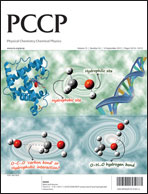Multiway study of hybridization in nanoscale semiconductor labeled DNA based on fluorescence resonance energy transfer†
Abstract
The resolution of the ternary–binary complex competition of a target sequence and of its two complementary probes in sandwich DNA hybridization is reported. To achieve this goal, Fluorescence Resonance Energy Transfer (FRET) between oligonucleotide-functionalized quantum dot (QD) nanoprobes (QD donor–QD acceptor) upon hybridization with a label free target was monitored by two-dimensional photoluminescence excitation spectroscopy (2D-PLE). Detection of a target oligonucleotide strand, using sandwiched nanoassembly in a separation-free format, was performed with the appearance of a new feature in the photoluminescence excitation (PLE) plot. From the obtained data, energy transfer efficiency and Förster radius (R0) were calculated. In particular, our results demonstrated that energy transfer by using QD donor–QD acceptor FRET pairs is more efficient in comparison with QD donor–organic dye acceptor pairs. Soft and model based analysis of 2D-PLE data was implemented by means of PARAFAC and hard trilinear decomposition (HTD), allowing to fit a proper model for FRET-based sandwich DNA hybridization systems. This study is the first successful application of a multiway chemometric technique to consider FRET based DNA hybridization in sandwiched nanoassemblies. A multi-equilibria model was properly fitted to the data and confirmed there is a competition between ternary and binary complex formation. Equilibrium constants of DNA hybridization in sandwiched nanoassemblies were estimated for the first time. Equilibrium constants illustrated that the extent of hybridization in one side on the target strand depends on hybridization conditions on the other side of the strand. Effects of guanine (G) and cytosine (C) contents of strands on the extent and rate of hybridization were investigated. In addition to equilibrium constants of binary and ternary complexes, the pure profiles of all resolved structures were estimated. Ultimately, the described method calculated the analytical concentration of probes as a measure of surface modification yield with DNA using nonlinear fit analysis, without using any calibration sample.


 Please wait while we load your content...
Please wait while we load your content...